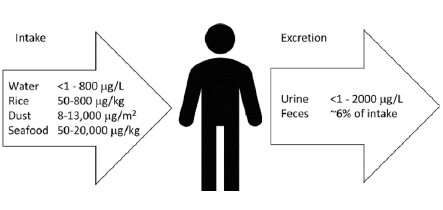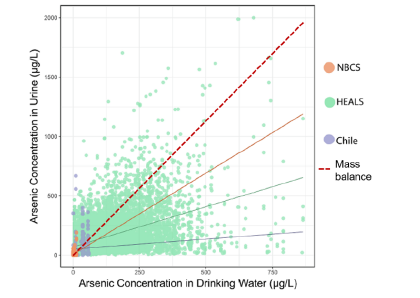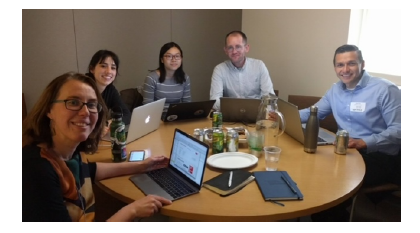Superfund Research Program
Combining Arsenic Data Across Populations Sheds Light on Exposure Sources
View Research Brief as PDF(1.1MB)
Release Date: 09/07/2022
![]() subscribe/listen via iTunes, download(5.9MB), Transcript(110KB)
subscribe/listen via iTunes, download(5.9MB), Transcript(110KB)
By combining data across three different populations, NIEHS Superfund Research Program (SRP) researchers were able to better characterize sources of arsenic exposure that should be included in risk assessments. The study was a collaboration among the University of California (UC), Berkeley, University of New Mexico (UNM), and Columbia University SRP centers.
Arsenic, naturally found in earth's crust, is associated with a range of health problems including diabetes, cardiovascular disease, and cancer.
Health risk estimates are primarily based on exposure to arsenic in drinking water. Arsenic is mostly excreted from the body through urine. But the researchers found that comparisons of levels of arsenic that people ingest to levels of arsenic that they excrete were inconsistent. They believed that revealing other exposure sources in water, food, and dust might be important, especially for specific populations.
Mass Balance Approach Across Three Countries
The team implemented a mass balance model, which follows the principle that the amount of arsenic entering the body should be similar to the amount that exits the body, to make excretion and intake more comparable.

Their study included arsenic concentrations in urine and environmental samples from three existing SRP-funded datasets:
- Columbia's Health Effects of Arsenic Longitudinal Study (HEALS) population in Bangladesh, primarily exposed to arsenic via contaminated drinking water in private wells.
- UC Berkeley's cohort of adults in Northern Chile, mainly exposed to arsenic via water and diet.
- UNM's Navajo Nation Birth Cohort Study (NBCS) in the U.S, exposed to arsenic in water and dust released from abandoned uranium mine waste piles.
A More Complete Picture
They first analyzed whether arsenic concentrations in drinking water matched concentrations in urine and found that using drinking water data alone was insufficient to achieve mass balance. According to the researchers, their results show that current studies relying on drinking water arsenic may be underestimating total arsenic exposure, as well as health effects relative to dose.

The collaborators then added data on arsenic from additional environmental samples:
- For HEALS, they included rice and private or public wells that were likely drinking water sources.
- For the Chilean population, they added foods, including fish, seafood, eggs, and vegetables.
- For NBCS, they looked at house dust.
The team observed that considering arsenic intake from the additional exposure routes specific to each population significantly improved the match between arsenic intake and excretion for the HEALS and NBCS populations.
According to the researchers, this is the first study to report the role of indoor dust in arsenic exposure for the Navajo Nation.
For the Chilean population, including diet in the analysis did not change the results. The authors explained that multiple factors may play a role in the variability observed in this cohort, including the time of the day when the urine sample was collected, temporal variability associated with diet, and individual meal preferences.
According to the team, characterizing these additional sources of arsenic exposure has important implications for better understanding associations between chemical exposure and disease in human studies.
Data Management Supplement

Funded by an SRP data management supplement, the three collaborators sought to make their individual projects' data accessible and reusable by sharing their data, metadata, and analytical code.
The team developed a data dictionary to describe common project-specific terminology, such as specific definitions, names, measurement units, and other attributes about data elements. This data dictionary allowed the team to harmonize their data and successfully use it for analysis.
For More Information Contact:
Alexander F van Geen
Columbia University
Lamont-Doherty Earth Observatory-The Earth Institute
206 Core Lab
Palisades, New York 10964
Phone: 845-365-8644
Email: avangeen@ldeo.columbia.edu
Andres Cardenas
Stanford University
Department of Epidemiology and Population Health
Research Park
Stanford, California 94305-5405
Phone: 650-497-2815
Email: andresca@stanford.edu
Johnnye L. Lewis
University of New Mexico
1 University of New Mexico
MSC09 5360
Albuquerque, New Mexico 87131-0001
Phone: 505-272-4853
Email: jlewis@cybermesa.com
To learn more about this research, please refer to the following sources:
- Beene D, Collender P, Cardenas A, Harvey CF, Huhmann LB, Lin Y, Lewis JL, Lolacono NJ, Navas-Acien A, Nigra AE, Steinmaus CM, van Geen AF. 2022. A mass-balance approach to evaluate arsenic intake and excretion in different populations. Environ Int 166:107371. doi:10.1016/j.envint.2022.107371 PMID:35809487
To receive monthly mailings of the Research Briefs, send your email address to srpinfo@niehs.nih.gov.


